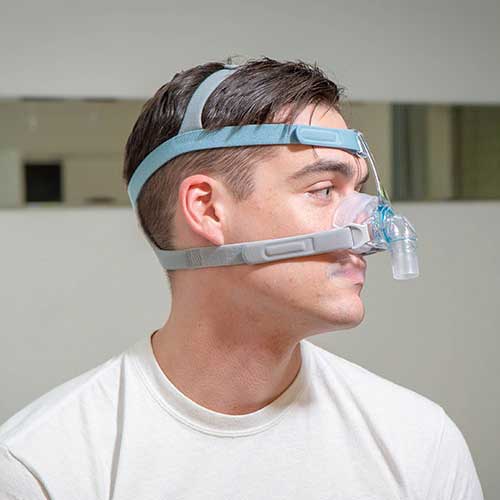SomniFix Mouth Strips are the best CPAP machine hack for overcoming mouth breathing and optimizing this sleep apnea treatment.
If you use a CPAP machine, you know first-hand the serious implications of mouth breathing1. Maybe mouth breathing has forced you to switch from a nasal mask or nasal pillows to a full-face mask, a higher-pressure variant of CPAP delivery. Maybe you simply can’t wear the mask all night. Inexplicably, CPAP adherence and compliance are defined as four (4) hours of use per night2. Because of poor CPAP compliance rates, using the device half the night is considered sufficient. Can you imagine another essential product whose use for only half of its prescribed time would be accepted? Perhaps a pacemaker? Or an oxygen delivery device? Half-use for those products would be unacceptable and could be a death sentence, and CPAP should be held to the same standard.

The side effects of unmanaged Obstructive Sleep Apnea (OSA) are serious: Among its many side effects are cardiovascular dangers such as high blood pressure3, congestive heart failure4, and stroke5; Type 2 diabetes6; and cognitive decline such as dementia and Alzheimer’s disease7. However, the use of clinical interventions for OSA, such as CPAP, can prevent and, in some cases, reverse the onset of OSA side effects. But how can patients expect to improve their sleep and their health if they are unable to use the device specifically meant to accomplish that goal? To solve OSA and its side effects, you must use CPAP all night.
In order to use CPAP all night, though, you must solve the leading cause of non-compliance and non-adherence: mouth breathing1. Mouth breathing allows for air leaks that compromise CPAP efficacy, as air delivered through the nose exits the open mouth before reaching the respiratory airway. These air leaks often awaken users, causing sleep fragmentation. Conversely, with the mouth closed, the air delivered from CPAP isn’t rerouted, but travels through the respiratory airway. Simply closing the mouth causes your CPAP to work wonders and helps you sleep through the night.

There has been no comfortable, gentle solution to keep the mouth closed while using CPAP. Bulky devices called chin straps are widely employed, but these devices come with many downsides. Chin straps fit tightly around the head, locking the jaw in a closed position, and they often lead to pain in the jaw known as TMJ. Chin straps also do not ensure that the mouth stays closed. While they close the jaw, the lips can still part, meaning that oral air leaks, and the resulting reduced CPAP efficacy, still occur. Fortunately, there’s a better way.
We created a complementary product to help CPAP users achieve the until-now unachievable: perfect compliance and adherence. SomniFix® Strips gently and non-invasively hold the lips closed to solve oral air leaks without interfering with CPAP masks. The strips, which stick to the lips, allow natural face movement, meaning no jaw pain or discomfort. The gentle adhesive allows for painless removal in the morning with no pressure marks. By wearing SomniFix® Strips, CPAP users experience improved compliance and adherence. When we spoke to CPAP users, the single biggest obstacle to achieving compliance and adherence was the sleep fragmentation caused by mouth breathing itself or the discomfort caused by mediocre products like chin straps. We solve that. Managing your sleep apnea does not have to be a nightmare.
One note before we proceed: SomniFix Strips are not indicated to solve OSA as a standalone. The Strips are only recommended to be used in combination with a CPAP machine or oral appliance.
Are you ready to experience CPAP compliance? Try SomniFix® Strips with your mask and experience a truly compliant night of CPAP therapy.
1. Bachour, A., & Maasilta, P. (2004). Mouth breathing compromises adherence to nasal continuous
positive airway pressure therapy. Chest, 126(4), 1248-1254. Abstract:
https://www.ncbi.nlm.nih.gov/pubmed/15486389
2. Masa, J. F., & Corral-Peñafiel,
J. (2014). Should use of 4 hours continuous positive airway pressure per night be considered acceptable compliance?.
Full text: https://erj.ersjournals.com/content/44/5/1119
3. Dopp, J. M., Reichmuth,
K. J., & Morgan, B. J. (2007). Obstructive sleep apnea and hypertension: mechanisms, evaluation, and management.
Current hypertension reports, 9(6), 529. Abstract:
https://www.ncbi.nlm.nih.gov/pubmed/18367017
4. Naughton, M. T., & Bradley, T.
D. (1998). Sleep apnea in congestive heart failure. Clinics in chest medicine, 19(1), 99-113. Abstract:
https://www.ncbi.nlm.nih.gov/pubmed/9554221
5. Redline, S., Yenokyan, G., Gottlieb,
D. J., Shahar, E., O'connor, G. T., Resnick, H. E., ... & Ali, T. (2010). Obstructive sleep apnea–hypopnea and
incident stroke: the sleep heart health study. American journal of respiratory and critical care medicine, 182(2),
269-277. Full text: https://www.ncbi.nlm.nih.gov/pmc/articles/PMC2913239/
6.
Doumit, J., & Prasad, B. (2016). Sleep apnea in type 2 diabetes. Diabetes Spectrum, 29(1), 14-19. Full text:
https://www.ncbi.nlm.nih.gov/pmc/articles/PMC4755452/
7. Sharma, R. A., Varga, A.
W., Bubu, O. M., Pirraglia, E., Kam, K., Parekh, A., ... & Tweardy, S. (2018). Obstructive sleep apnea severity
affects amyloid burden in cognitively normal elderly. A longitudinal study. American journal of respiratory and
critical care medicine, 197(7), 933-943. Full text:
https://www.ncbi.nlm.nih.gov/pmc/articles/PMC6020410/



